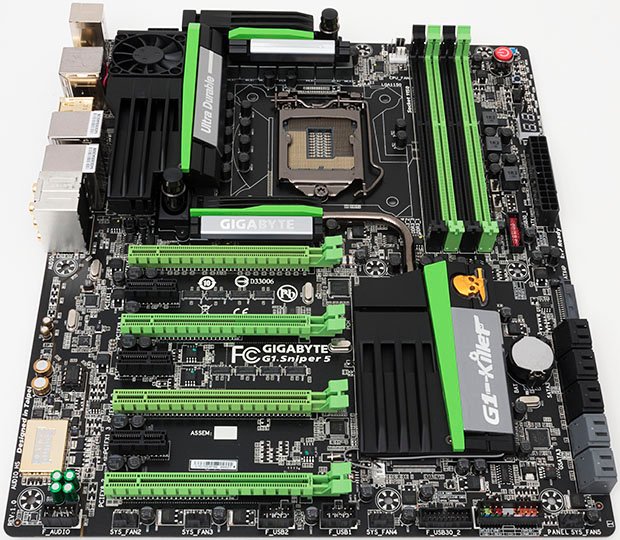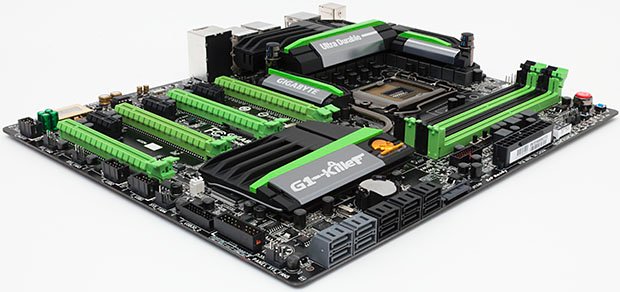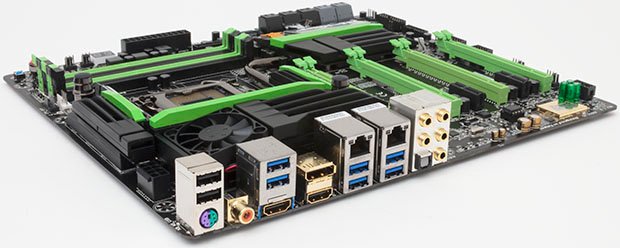 Gigabyte, the components specialist, sent us the G1.Sniper 5 Motherboard a couple of days ago for review. This one comes packed with almost everything you’ll ever need to build a high-performance gaming PC. The motherboard is based on Intel’s latest Z87 chipset and comes packed with a set of new and improved features to take full advantage the Intel 4th Gen Core processor in an LGA 1150 package.
Gigabyte, the components specialist, sent us the G1.Sniper 5 Motherboard a couple of days ago for review. This one comes packed with almost everything you’ll ever need to build a high-performance gaming PC. The motherboard is based on Intel’s latest Z87 chipset and comes packed with a set of new and improved features to take full advantage the Intel 4th Gen Core processor in an LGA 1150 package.
What’s more, the Gigabyte G1.Sniper 5 Motherboard is an industry first that allows you to customise the onboard operational amplifier. It also comes loaded with dual networking, maxed out multi-card gaming support, advanced cooling, and cool looks – so on paper it seems like a match for serious gamers. Let’s see how it performs in real works tests.
First things first – the G1. Sniper 5 has some killer looks and good feature-sets. It has a bigger footprint than standard ATX motherboard – since it is 0.8-inch wider, the motherboard easily gets into the XL-ATX category. Hence, the motherboard may not fit into smaller ATX cases.

Inside the box, the G1. Sniper 5 comes with a list of accessories. This includes an IO shield, six ix SATA 6Gbps data cables, a USB 3.0 front adapter bracket with two USB 3.0 / 2.0 ports, a ribbon style 2-way SLI Bridge cable, a PCB style 3-way SLI bridge cable, a ribbon style 2-way CrossFire cable, a PCB style 4-way SLI bridge cable, an additional op-amp for the onboard audio with IC extractor, a GIGABYTE sticker, PCIe x1 WiFI + Bluetooth adapter, a single bi-pole antenna for the WiFI card, quick installation guide, a User Manual, and two driver and utilities DVDs. That’s a mouthful!
The G1. Sniper 5 also comes with a selection of software applications such as the “Killer” NPU Software Stack for the includes Qualcomm Atheros ‘Killer’ E2205 network processing unit, Sound Blaster Pro Studio for the included Creative Core3D audio chipset and its associated controller, Gigabyte App Center, the @BIOS program which lets you flash the BIOS, and a USB Blocker program that lets anyone with administrator rights the ability to pick and choose what types of USB devices can be seen by the OS. In addition, Gigabyte also bundles an EZ Setup that gives users a simple way to quickly and easily switch between IDE, RAID and AHCI disk modes from within Windows without having to modify or re-install the OS.
The G1. Sniper 5 allows you to add up to four graphics cards and 10 storage devices – so it is imperative you have a huge PC enclosure to accompany all of that configuration. The motherboard also supports quad CrossFire and SLI configs – this is quite impressive because usually most Z87 boards are limited to two-card setups that split the CPU’s 16 PCIe Gen3 lanes evenly between a pair of x16 slots.
The rear cluster of the motherboard includes pretty much everything you would ever need in terms of connectivity. There’s one DisplayPort out, six USB 3.0 ports, and pairs of HDMI, S/PDIF audio, Gigabit Ethernet, and USB 2.0 ports. There’s even a combo PS/2 jack for conncting a keyboard.

We used a Windows 8 based test bench for this review that included an Intel Core i5-4670K processor running at 3.40-GHZ. The processor was provided by Gigabyte for this review. The test bench also included 2 X 8GB DDR3 SDRAM, a 256 GB SSD, and an 800 W PSU. As mentioned earlier, we used Microsoft Windows 8 Enterprise 64 bit operating system for the real world tests.
Most motherboards today have little impact on overall system performance. The CPU and GPU generally dictate application and gaming performance, while the storage subsystem—specifically, whether there’s an SSD installed—can influence load times and general responsiveness. We ran a couple of motherboard benchmark suites to assess the overall performance and power consumption.
The G1. Sniper 5 boots a few seconds slower than most of the Z87 boards we’ve tested in the past. We recorded 23 seconds for it to get to the Windows 8 Start screen, with all the fast-boot options enabled. That might probably be because the G1. Sniper 5 has more on-board peripherals than most same-class motherbaords on the market. When it comes to power consumption, the G1. Sniper 5 consumers far less power than most Z87 boards on the market.

Gigabytes’s G1 series of motherboards are commendable and are one of the most highly regarded on the market. The G1.Sniper 5 does offer a lot more features and add-ons that its predecessors, in a well implemented gamer-focused design. Thus, the G1. Sniper 5 is truly the best G1 motherboard Gigabyte has ever produced and arguably one of the best LGA 1150 gaming orientated motherboard’s available on the market today.
Of course, the G1. Sniper 5 motherboard flashes an expensive pricetag. But then, it makes up for the high price tag by offering better hardware, software, PC gaming abilities, overclocking abilities or any combination thereof. The Gigabyte G1. Sniper 5 thus wins Review Central’s Recommended award.
Price: AED 1800 Approx.
Specifications:
Platform: Intel Z87 Express, socket LGA1150
DIMM slots: 4 DDR3, 32GB max
Expansion slots: 4 PCIe 3.0 x16 via CPU and PLX PEX8747 switch (x16/x16, x16/x8/x8, x8/x8/x8/x8), 3 PCIe x1 via Z87
Storage I/O: 6 SATA RAID 6Gbps via Z87, 4 SATA 6Gbps via Marvell 88SS9230
Audio: 6-channel HD via Creative Sound Blaster Recon3Di
Wireless: 2.4/5GHz Dual-band 802.11n Wi-Fi via Atheros AR5B22, Bluetooth 4.0
Ports: 2 HDMI, 1 DisplayPort, 1 PS/2 keyboard/mouse, 6 USB 3.0 via Renesas uPD720210, 2 USB 3.0 internal headers via Z87, 2 USB 3.0 internal headers via uPD720210, 2 USB 2.0 via Z87, 6 USB 2.0 internal headers via Z87, 1 Gigabit Ethernet via Qualcomm Atheros Killer E2201, 1 Gigabit Ethernet via Intel I217-V, 1 analog front out, 1 analog center out, 1 analog rear out, 1 analog line in/mic in, 1 analog headphone out, 1 digital S/PDIF output
Overclocking: Per-core Turbo multiplier: 8-80X, Uncore multiplier: 8-80X, Base clock: 80-266.66MHz, DRAM clock: 800-2933MHz, CPU gear ratio: 1.0, 1.25, 1.66, 2.5, CPU voltage: 0.5-1.8V, CPU core offset voltage: -0.3-0.4V, IGP voltage: 0.5-1.7V, IGP offset voltage: -0.3-0.4V, CPU ring voltage: 0.8-1.8V, CPU ring offset voltage: -0.3-0.4V, CPU external override voltage: 1.0-2.905V, System Agent offset voltage: -0.3-0.4V, Analog I/O offset voltage: -0.3-0.4V, Digital I/O offset voltage: -0.3-0.4V, PCH core voltage: 0.65-1.3V, PCH IO voltage: 1.05-1.9V, DRAM voltage: 1.15-2.1V
Fan control: All: predefined silent, normal profiles, CPU, CPU Opt, SYS1-4 slope PWM: 0.75-2.5








